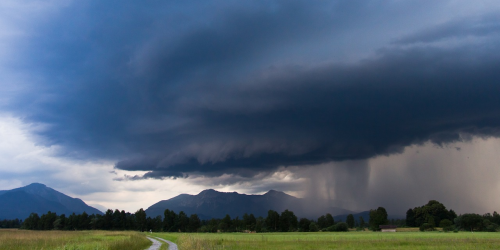CPO’s National Integrated Drought Information System (NIDIS) Program is announcing seven new 2-year projects in Fiscal Year 2022 (FY22), focused on research and tools to improve our understanding and management of drought risk in terrestrial and aquatic ecosystems to inform more deliberate and expanded decision-making that supports sustainable, healthy, and resilient ecosystems. The competitively selected projects total $3,847,0221, including $3,275,135 in cooperative agreements and $571,887 in other awards.


Credit: Shutterstock/Francisco Blanco
Drought has traditionally been viewed in terms of its agricultural, hydrological, and socioeconomic impacts. This lens, however, does not fully address the impacts to ecosystems, and the services they provide. Healthy ecological systems support every form of life by providing food, water, and energy; regulating pests, floods, and diseases; supporting spiritual, recreational, and cultural activities; and sustaining other critical functions. Drought can alter or degrade any or all of these functions and services at a local, landscape, or system scale.
For the FY22 Coping with Drought – Ecological Drought competition, NIDIS encouraged applicants to focus research on two areas: (1) improving our ability to understand drought impacts to ecosystems and ecologically available water and integrating that information into decision-making and (2) integrating ecologically-relevant information to support drought monitoring, planning, and action. Applicants were asked to apply these questions in natural systems (e.g., freshwater, coastal, wetland, grasslands, rangeland, forest ecosystems, and/or aquaculture). Outcomes from this research will improve our understanding and management of drought risk in terrestrial and aquatic ecosystems and will complement research being implemented by other federal programs such as the U.S. Geological Survey Climate Adaptation Science Centers.
The seven new projects2 funded by NIDIS in FY22 are:
- Connecting Ecological Drought Monitoring Tools with Natural Resource Stakeholders in Montana
Montana and surrounding states have experienced two severe drought events during the past five years. During this project, we will develop new ecologically relevant drought monitoring tools and assess the ability of traditional drought indicators to accurately represent ecological drought conditions. Extensive social science tasks will allow us to contribute valuable information and guidance to the Montana drought advisory committee regarding the timing of management decisions made by natural resource stakeholders, the existing tools and trigger points that are used when making those decisions, and how new ecological drought monitoring tools could be incorporated into their decision-making process.- PIs: Jason Otkin, University of Wisconsin-Madison, Jamie McEvoy, Montana State University, and Tonya Haigh, University of Nebraska-Lincoln
- Co-PIs: Sarah Church, Montana State University, and Paul Stoy and Yafang Zhong, University of Wisconsin-Madison
- Drought Effects on Coastal Restoration Success: Quantifying Impacts and Testing Strategies to Enhance Resilience
Salt marshes are usually wet places covered with lots of plants. Like other coastal ecosystems, they are exceptionally vulnerable to climate change impacts including sea level rise. When projects restore lost marshes, the starting point is a bare landscape. Longer and more intense droughts can decrease the success of restoration projects. This project will provide novel scientific information about drought effects on marsh restoration by looking at the causes of plant death and testing whether providing freshwater with temporary sprinklers can help jumpstart plant growth at restoration sites.- PI: Anna Braswell, University of Florida
- Co-PIs: Margaret Zimmer, University of California-Santa Cruz, Monique Fountain and Kerstin Wasson, Elkhorn Slough National Estuarine Research Reserve
- A Communication Framework for Ecological Drought Information in the Southwestern US
What we learn from recent drought experiences can help reduce the social and environmental effects of future droughts. One of the challenges is in connecting scientific research with ranchers and other land managers whose day-to-day decisions determine how the next drought will affect not just their own herds, but the complex ecosystems that support cattle and many other species. The proposed research will incorporate data and observations from on-the ground decision-makers, using state-of-the art technology, including remote sensing and machine learning, to boil down vast amounts of data for easier use. The new “EcoDri” framework for delivering information will be rooted in the needs and preferences of users with boots on the ground, allowing them to both provide information and to access streams of clearly condensed, relevant data.- PI: Hatim Geli, New Mexico State University
- Co-PIs: David Dubois, Lara Prihodko, and Casey Spackman, New Mexico State University and Kelly Smith, University of Nebraska-Lincoln
- Projecting Socio-Ecological Impacts of Drought in Southwestern Ecosystems to Prioritize Restoration Initiatives
The Southwest United States is experiencing more frequent and severe droughts, leading to unprecedented die-offs of foundational plant species across ecosystems. For Native American tribes, loss or movement of plants used for food, ceremonies, medicine, or art imperils cultural practices tied to those species. Here, we combine information on social connections to natural areas with ecological data to identify ecocultural hotspots that are vulnerable to drought. Using this information, we will identify priority sites for restoration treatments that mitigate ecocultural losses.- PI: Sara Souther, Northern Arizona University
- Co-PIs: Diana Stuart, Northern Arizona University and Steven Chischilly, Navajo Technical University
- An Integrated Framework for Drought Response in Southern California’s Natural Landscapes
Southern California is an ecologically diverse region threatened by urbanization, water scarcity, and shifting wildfire frequency. As a biodiversity hotspot with a population of more than 21 million people and an economy of nearly $1.3 trillion GDP, a comprehensive drought preparedness and response strategy that considers the interrelated nature of these threats is needed. This project will help build regional understanding of the vulnerabilities and effects of ecological drought for conservation and natural resource management.- PIs: Megan Jennings, San Diego State University and Amber Pairis, Desert Research Institute
- Building a More Drought-Resilient Urban Forest Ecosystem
Trees and urban forests provide important services in cities around the world but grow in stressful environments that exacerbate drought stress. Management before, during, and after a drought event can improve tree and forest resilience, but many regions and cities lack robust information and communication pathways to provide early warning and targeted intervention recommendations. The goal of this project is to strengthen drought and climate resilience in urban forests by extending existing drought monitoring and early warning systems to urban settings.- PI: Christine Rollinson, The Morton Arboretum
- Co-PIs: M. Ross Alexander, University of Chicago, Trent Ford, University of Illinois, and Luke McCormack, Jake Miesbauer and Lydia Scott, The Morton Arboretum
- Building a Drought Early Warning System for Coldwater Fisheries Management across the Northern Rocky Mountains
Climate change is increasing the frequency and severity of droughts, posing a critical threat to freshwater ecosystems. This is particularly concerning for coldwater trout fisheries that have enormous ecological, cultural, and economic importance across the western United States. This project will use long-term trout monitoring data to understand how extreme conditions during drought, including low river levels and warm temperatures, have impacted Montana’s famed trout fisheries over the past 30 years. The final product will be a first-of-a-kind drought early warning system that can be used by managers and the public to prepare, mitigate, and manage valuable freshwater fisheries under climate change and drought. This information will be made publicly available through a web tool called “Fish-Cast” to increase awareness and preparedness for drought events and impacts on trout fisheries.- PI: Timothy Cline, US Geological Service Northern Rocky Mountain Science Center
- Co-PI: Clint Muhlfeld and Gregory Pederson, US Geological Service Northern Rocky Mountain Science Center
The National Integrated Drought Information System (NIDIS), authorized in 2006, is a multi-agency partnership that coordinates drought monitoring, forecasting, planning, and information at national, state, and local levels across the country. NIDIS aims to help the nation move to an increasingly proactive approach to understand and manage drought risks and impacts, and to improve long-term drought resilience.
1The funding will be distributed over the life of the projects and future-year funding is conditional on appropriations.
2 At the time of publication, all awards may not have been accepted by recipient institutions





